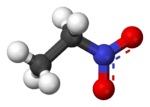Nitroethane
Nitroethane is an organic compound having the chemical formula C2H5NO2. Similar in many regards to nitromethane, nitroethane is an oily liquid at standard temperature and pressure. Pure nitroethane is colorless and has a fruity odor.
| |||
 | |||
| Names | |||
|---|---|---|---|
| IUPAC name
Nitroethane | |||
| Identifiers | |||
3D model (JSmol) |
|||
| ChEBI | |||
| ChEMBL | |||
| ChemSpider | |||
| ECHA InfoCard | 100.001.081 | ||
| KEGG | |||
PubChem CID |
|||
| RTECS number |
| ||
| UNII | |||
| UN number | UN 2842 | ||
CompTox Dashboard (EPA) |
|||
| |||
| |||
| Properties | |||
| C2H5NO2 | |||
| Molar mass | 75.067 g·mol−1 | ||
| Density | 1.054 g/cm3 | ||
| Melting point | −90 °C (−130 °F; 183 K) | ||
| Boiling point | 112.0 to 116.0 °C (233.6 to 240.8 °F; 385.1 to 389.1 K) | ||
| Slightly soluble (4.6 g/100 ml at 20 °C) | |||
| Vapor pressure | 21 mmHg (25 °C)[1] | ||
| Acidity (pKa) | 16.7[2][3] | ||
| -35.4·10−6 cm3/mol | |||
| Viscosity | 0.677 Pa·s at 20 °C | ||
| Hazards | |||
| Main hazards | Flammable, harmful | ||
| Safety data sheet | MSDS at fishersci.com | ||
| GHS pictograms |    | ||
| GHS Signal word | Danger | ||
GHS hazard statements |
H226, H302, H315, H331, H341, H412 | ||
| P210, P261, P312, P301, P330, P304, P340, P312, P370, P378, P403+233 | |||
| NFPA 704 (fire diamond) | |||
| Flash point | 28 °C (82 °F; 301 K) | ||
| Explosive limits | 3.4%-?[1] | ||
| Lethal dose or concentration (LD, LC): | |||
LC50 (median concentration) |
5000 ppm (rabbit, 2 hr)[4] | ||
LCLo (lowest published) |
6250 ppm (mouse, 2 hr)[4] | ||
| NIOSH (US health exposure limits): | |||
PEL (Permissible) |
TWA 100 ppm (310 mg/m3)[1] | ||
REL (Recommended) |
TWA 100 ppm (310 mg/m3)[1] | ||
IDLH (Immediate danger) |
1000 ppm[1] | ||
| Related compounds | |||
Related nitro compounds |
2-Nitropropane Nitromethane | ||
Related compounds |
Ethyl nitrite Ethyl nitrate | ||
Except where otherwise noted, data are given for materials in their standard state (at 25 °C [77 °F], 100 kPa). | |||
| Infobox references | |||
Preparation
Nitroethane is produced industrially by treating propane with nitric acid at 350–450 °C. This exothermic reaction produces four industrially significant nitroalkanes: nitromethane, nitroethane, 1-nitropropane, and 2-nitropropane. The reaction involves free radicals, such as CH3CH2CH2O., which arise via homolysis of the corresponding nitrite ester. These alkoxy radicals are susceptible to C—C fragmentation reactions, which explains the formation of a mixture of products.[5]
Alternatively, nitroethane can be produced by the Victor Meyer reaction of haloethanes such as chloroethane, bromoethane, or iodoethane with silver nitrite in diethyl ether or THF. The Kornblum modification of this reaction uses sodium nitrite in either a dimethyl sulfoxide or dimethylformamide solvent.[6]
Uses
Via condensations like the Henry reaction, nitroethane converts to several compounds of commercial interest. Condensation with 3,4-dimethoxybenzaldehyde affords the precursor to the antihypertensive drug methyldopa; condensation with unsubstituted benzaldehyde yields phenyl-2-nitropropene. Nitroethane condenses with two equivalents of formaldehyde to give, after hydrogenation, 2-amino-2-methyl-1,3-propanediol, which in turn condenses with oleic acid to give an oxazoline, which protonates to give a cationic surfactant.[5]
Like some other nitrated organic compounds, nitroethane is also used as a fuel additive and a precursor to Rocket propellants.
Nitroethane is a useful solvent for polymers such as polystyrene and is particularly useful for dissolving cyanoacrylate adhesives. In cosmetics applications, it has been used as a component in artificial nail remover and in overhead ceiling sealant sprays.
Nitroethane was previously used successfully as a chemical feedstock (precursor ingredients) in laboratories for the synthesis of multitudes of substances and consumer goods, for e.g. the medicine Pervitin's use was common in the 19th and 20th century (especially popular during WW2 by the allied troops and nazis alike for mood elevation, appetite and sleep suppression and increasing focus, alertness) nitroalkanes were one of many ingredients used in the synthesis of many phenethylamines, including medications such as Pervitin and the racemic compound Benzedrine.[7] an anorexic medicine for obesity .[8]
Toxicity
Nitroethane is suspected to cause genetic damage and be harmful to the nervous system. Typical TLV/TWA is 100 ppm. Typical STEL is 150 ppm. Skin contact causes dermatitis in humans. In animal studies, nitroethane exposure was observed to cause lacrimation, dyspnea, pulmonary rales, edema, liver and kidney injury, and narcosis.[9] Children have been poisoned by accidental ingestion of artificial nail remover.[10]
The LD50 for rats is reported as 1100 mg/kg.[11]
References
- NIOSH Pocket Guide to Chemical Hazards. "#0453". National Institute for Occupational Safety and Health (NIOSH).
- Reich, Hans. "Bordwell pKa table: "Nitroalkanes"". University of Wisconsin Chemistry Department. Retrieved 17 January 2016.
- Matthews, Walter; et al. (1975). "Equilibrium acidities of carbon acids. VI. Establishment of an absolute scale of acidities in dimethyl sulfoxide solution". Journal of the American Chemical Society. 97 (24): 7006. doi:10.1021/ja00857a010.
- "Nitroethane". Immediately Dangerous to Life and Health Concentrations (IDLH). National Institute for Occupational Safety and Health (NIOSH).
- Sheldon B. Markofsky “Nitro Compounds, Aliphatic” in Ullmann's Encyclopedia of Industrial Chemistry, Wiley-VCH, Weinheim, 2002. doi:10.1002/14356007.a17_401.
- Agrawal, Jai (2007). Organic Chemistry of Explosives. Chichester, England: John Wiley & Sons. pp. 7–10. ISBN 9780470029671.
- "2016 National Drug Assessment Summary" (PDF). Drug Administration. November 2016.
- "2016 National Drug Assessment Summary" (PDF). Drug Administration. November 2016.
- "Chemical Sampling Information Nitroethane." Retrieved February 9, 2007, from the website of the US Occupational Safety & Health Administration.
- Hornfeldt CS, Rabe WH (1994). "Nitroethane poisoning from an artificial fingernail remover". J. Toxicol. Clin. Toxicol. 32 (3): 321–4. doi:10.3109/15563659409017967. PMID 8007041.
- MSDS for nitroethane (revised October 3, 2005), as reported by Fisher Scientific.

